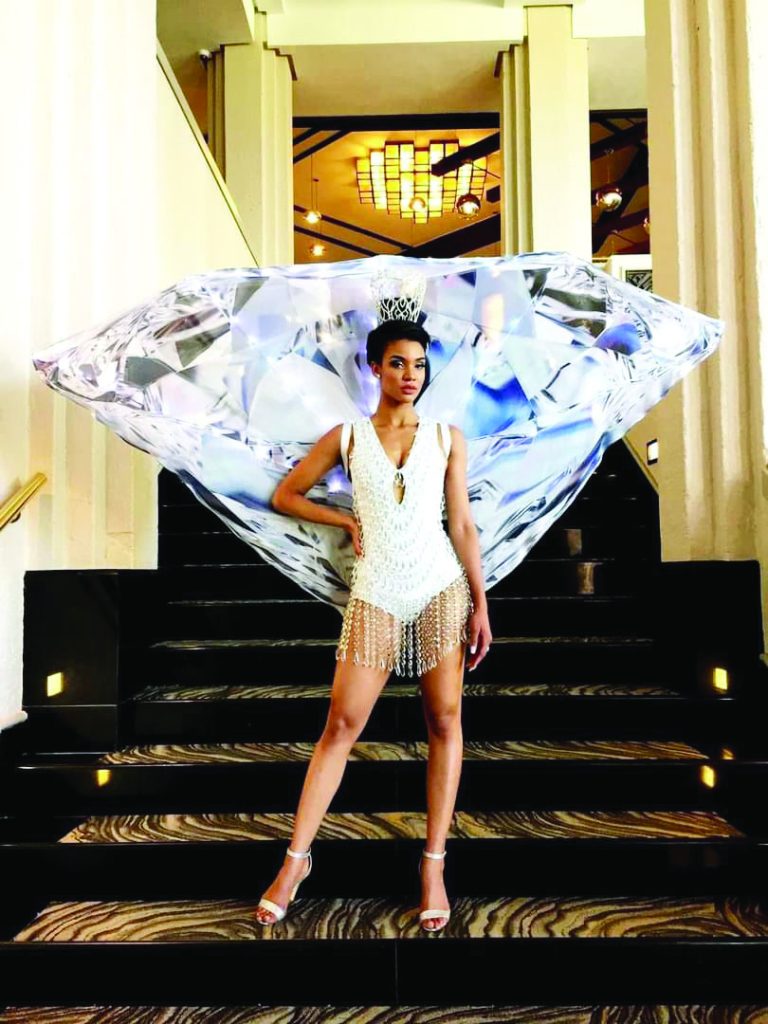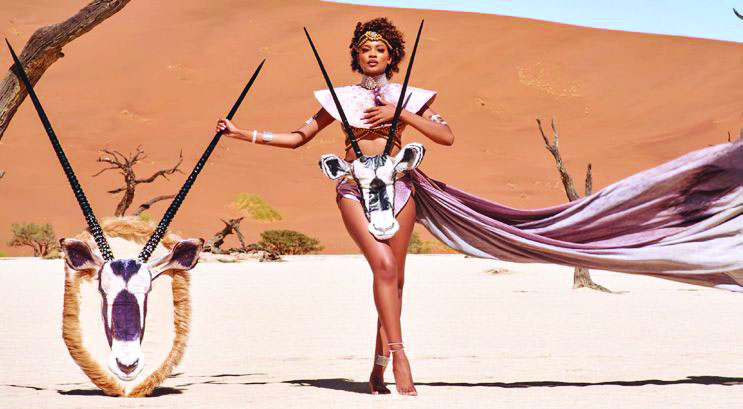Miss Namibia’s national costume has been a source of pride and debate, sparking discussions on social media and in public forums.
Each year, Namibians eagerly await the reveal of a design that will represent their country on the Miss Universe stage. Yet, while some costumes are embraced with enthusiasm, others face criticism.
Miss Namibia national director Umbi Karuaihe-Upi, who has overseen Miss Namibia’s costume process for years, says the national costume is about more than just aesthetics; it’s an expression of Namibia’s unique identity, heritage and pride.
“The design process is done through discussions with the Miss Namibia team as well as with the delegate herself, whose input is highly valued,” she says.
The costume represents Namibia’s “cultures, landmarks, generational customs”, and is intended to foster national pride.
The design process is intentional and collaborative, with a focus on cultural congruence. Yet, while national pride remains the primary focus, Karuaihe-Upi acknowledges that public opinion is crucial.
“Miss Namibia is owned by the public. I’m a servant of the public, so if they are not happy, I have to be humble and see how I can change the situation,” she says, adding that there will always be “hits and misses”.
Former Miss Namibia Odile Gertze, who wore the crown in 2010, has praise for this year’s costume.
“I do love the national costume,” Gertze says. “The basket detail and lamp earrings are stunning! This is the type of national costume that truly represents Namibia.”
She sees this year’s piece as a positive shift and hopes it sets a precedent for future costumes.
“Hopefully this sets the right tone for the coming years, because we are an incredibly diverse country with so much to offer. We can do better, and I’m happy to say that this year did better.”
Symbolism Behind National Costumes
The national costume may not contribute points to a Miss Universe contestant’s overall ranking, but for Namibia, it is a statement of identity.
The ‘Desert Mirage’ costume of 2024, for example, pays tribute to Namibia’s renowned landscapes, incorporating symbolic elements such as desert sand to reflect the dunes and sparkly details inspired by the nation’s diamond wealth.
As NBC director general Stanley Similo says, the costume aims to embody “what Namibia stands for as a country”, illustrating its beauty and diversity.
Incorporating national symbols into these costumes has been a recurring theme.
Jameela Uiras’ 2023 costume was inspired by the oryx, one of Namibia’s most iconic animals, and reflected national resilience and pride. Diana Andimba’s pangolin-themed costume and Martha Kautanevali’s aloe tree costume aimed to capture the spirit of Namibia’s flora and fauna, grounding them in cultural and environmental narratives.
Public Reception
The public’s reception of Miss Namibia’s national costumes has been varied. On social media, there are sometimes harsh criticisms as well as positive feedback from those who feel the costumes either hit the mark or miss it altogether.
Namibian designer and MTC Windhoek Fashion Week co-founder Luis Munana suggests a more inclusive approach to the costume design process.
“I think the national costume should not be a situation where we wait for Miss Namibia to be crowned, then start to produce the costume. It should involve the public. Designers from across Namibia should submit their designs, and the public should vote.”
This year, the odelela fabric costume by Puurfekt Studio was inspired by the attire of northern Namibians and blended cultural heritage with modern elegance. Although the reveal of this year’s costume has received mixed reactions, the cream and gold were intended to honour Namibia’s diverse ethnic groups and heritage.
Accessories such as lantern earrings and a basket crown symbolise the weaving traditions of the Zambezi, Kavango and Aawambo people, and the fitted silhouette fuses traditional and modern aesthetics. However, social media responses varied, with some calling it a “cocktail of laziness” and “lacking creativity”, while others appreciated the cultural references and intricate design.
According to online comments, there is a recurring expectation for these costumes to represent Namibia as a whole.
“National costumes are meant to represent the nation, not a particular tribe,” one user wrote, reflecting a sentiment that costumes sometimes emphasise regional or cultural specifics rather than a holistic view of Namibian identity.
Fashion Industry Perspectives
Award-nominated stylist Hilay Wang emphasises the need for “cultural authenticity, visual impact and innovation”.
Wang believes successful costumes incorporate indigenous patterns, symbols and materials native to Namibia, creating a “balance between heritage and modernity”.
According to Wang, Tsakana Ndakandih’s feathered costume in 2012 and Selma Kamanya’s minimalist diamond-themed costume in 2018 are examples of successful costumes that resonated with audiences, combining storytelling with visual elements.
The costumes of Chelsi Shikongo and Jameela Uiras are also examples of meaningful designs.
Shikongo’s ‘Salt Pans of Walvis Bay’ costume celebrated the beauty of her hometown with hues of pink and white, incorporating Oshiwambo fabric, while Uiras’ diamond oryx theme represented resilience.
“Bold colours, dynamic accessories and interactive elements can create a moment of surprise,” Wang says, urging designers to think of national costumes as a form of symbolic storytelling.
Memorable Costumes Through the Years
2017: ‘Save the Rhinos’, a costume honouring anti-poaching efforts.
2018: A diamond-inspired costume reflecting Namibia’s status as a diamond-producing nation.

2019: A costume symbolising Namibia’s people and animals, celebrating its diversity.
2021: Chelsi Shikongo’s salt pans costume, which used Oshiwambo fabric and referenced her Walvis Bay roots.
2023: Jameela Uiras’ diamond oryx costume, a tribute to Namibia’s resilience and beauty.

These costumes each attempted to tell a story about Namibia’s landscapes, animals and environmental challenges, highlighting the nation’s identity through visual design.
Embracing Inclusive Representation
There is a growing consensus that Miss Namibia’s national costume should be a collaborative effort, engaging more Namibian designers and allowing public participation.
Munana and others have suggested that opening the costume design process to a nationwide vote would foster a sense of collective identity and allow the public to feel more represented.
At its core, the Miss Namibia national costume is meant to inspire national pride and serve as an ambassador of Namibian culture.
Karuaihe-Upi acknowledges that “each costume bears a message of patriotism” and that, while public feedback will always vary, it remains an essential part of the process.
As Namibia continues to celebrate its culture through fashion, each costume – beloved or controversial – adds another chapter to the story of Namibian identity.
Stay informed with The Namibian – your source for credible journalism. Get in-depth reporting and opinions for
only N$85 a month. Invest in journalism, invest in democracy –
Subscribe Now!






